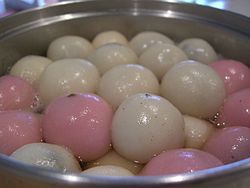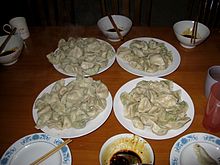Dongzhi Festival

| Dongzhi Festival | |
|---|---|
 Tangyuan, a traditional Dongzhi Festival food | |
| Observed by | Chinese people |
| Type | Cultural |
| Significance | Marks the winter solstice |
| Observances | making and eating of tangyuan, ancestor worship |
| Date | December solstice (between December 21 and December 23) |
| Frequency | annual |
| Related to | Winter solstice |
| Dongzhi Festival | |||||||||||||||||||||||||
|---|---|---|---|---|---|---|---|---|---|---|---|---|---|---|---|---|---|---|---|---|---|---|---|---|---|
| Chinese | 冬至 | ||||||||||||||||||||||||
| Literal meaning | winter's extreme (i.e. winter solstice) | ||||||||||||||||||||||||
| |||||||||||||||||||||||||
| Alternative Chinese name | |||||||||||||||||||||||||
| Traditional Chinese | 冬節 | ||||||||||||||||||||||||
| Simplified Chinese | 冬节 | ||||||||||||||||||||||||
| Literal meaning | winter festival | ||||||||||||||||||||||||
| |||||||||||||||||||||||||

The Dongzhi Festival or Winter Solstice Festival (Chinese: 冬至; pinyin: Dōngzhì; lit. 'winter's extreme') is a traditional Chinese festival celebrated during the Dongzhi solar term (winter solstice), which falls between December 21 and December 23.[1][2]
The origins of this festival can be traced back to the yin and yang philosophy of balance and harmony in the cosmos.[3] After this celebration, it is believed that days will have longer daylight hours and therefore create an increase in positive energy flowing in. The philosophical significance of this is symbolized by the I Ching hexagram fu (Chinese: 復, "Returning").
Traditional activities
[edit]In Chinese, the word "Dong" means "winter" while "Zhi" means "arrival" giving the literal meaning of the festival "the coming of winter". Dongzhi celebrates the winter solstice, usually around December 21 to 23, and is observed on the longest night of the year. Symbolizing the victory of light over darkness, Dongzhi, represents that the days will start to grow longer and bring a sense of balance and harmony to people's lives. Based on Chinese beliefs of yin yang, "Yang" represents positive energy, warmth, and light. Following the Dongzhi Festival, daytime will gradually lengthen, as "Yang" will also increase.[4] It was also believed by some that it was the day the Kitchen God went to heaven to report to the Jade Emperor the conduct of a family.[5]
The festival was first celebrated by the Chinese people during the Zhou dynasty (1045 BC–256 BC) and declared an official celebration during the Han dynasty (206 BC–220 AD). The Han people would take a break from work to celebrate with their families. They would hold heaven worshipping as well as honoring their ancestors by burning joss paper at their ancestral shrines to show gratitude.[6] In ancient times, the day was also known as the "festival of extreme length (traditional Chinese: 長至節; simplified Chinese: 长至节; pinyin: Cháng Zhì Jié) as the sun's extreme position lengthens shadows.[7]: 238 It was traditionally a very important holiday, comparable to Chinese New Year.[7]: 240–241
The Chinese people still celebrate certain practices during the Dongzhi festival, such as the union of family.[8] In Hong Kong, many businesses let employees off early to spend time with their families on this day,[8] while in some areas shops close for the holiday.[7]: 241 In Suzhou, it is traditional to light incense at dawn.[7]: 241
The Dongzhi Festival has historically been associated with various agricultural activities in China, particularly in rural areas. As the festival represents the winter solstice, it is a crucial time to harvest winter crops, such as wheat, barley, and radishes. It is also an important time to pay respect to certain livestock and feed these animals special meals to celebrate the occasion.[9]
Traditionally, the Dongzhi Festival is a time for families to eat together.[8] One activity that occurs during these get-togethers (especially in the Asia and in Overseas Asian communities) is the making and eating of tangyuan (湯圓) or balls of glutinous rice, which symbolize reunion.[10] Tangyuan are made of glutinous rice flour and are sometimes coloured pink or green. Each family member receives at least one large tangyuan in addition to several small ones. The flour balls are cooked in a sweet soup or savory broth with both the ball and the soup/broth served in one bowl. It is also often served with jiuniang, a mildly alcoholic, unfiltered rice wine containing whole grains of glutinous rice (and often also sweet osmanthus flowers).[11]
People typically eat Winter Solstice dumplings (Chinese: 冬至糰; pinyin: dōngzhìtuán),[12] which sounds like "reunion". This custom is said to have been started by the celebrated physician Zhang Zhongjing during the Han dynasty. One cold winter's day, he noticed that the poor were afflicted with chilblains on their ears. Moved to pity, he ordered his apprentices to make dumplings with lamb and other ingredients, and distribute them among the poor to keep them warm and prevent their ears from getting chilblains. Since the dumplings were shaped like ears, Zhang named the dish "qùhán jiāoěr tāng" (祛寒嬌耳湯) or dumpling soup that expels the cold. From that time on, it has been a tradition to eat dumplings on the day of Dongzhi. Dumplings are not only eaten by the family, but also shared with friends and relatives as a blessing. The dumplings may be molded into the shapes of animals such as dogs and cats.[12] Common superstitions include that married people should leave two uneaten to have their wishes come true, and a single person should leave one for an auspicious year.[12] According to one tradition, the dumplings should be eaten by an even number of people for good luck.[12] Many people take some of the tangyuan that have been used as offerings and stick them on the back of the door or on windows and tables and other pieces of furniture.[12] These "empowered" tangyuan serve as protective talismans to keep evil spirits away from children.
Old traditions also require people with the same surname or from the same clan to gather at their ancestral temples to worship on this day. There is always a grand reunion dinner following the sacrificial ceremony.
Other traditional foods include hot pot[13] and wontons.[7]: 241 Shuijiao dumplings are popular in northern China.[7]: 241
The festive food is also a reminder that celebrators are now a year older and should behave better in the coming year. Even today, many Chinese around the world, especially the elderly, still insist that one is "a year older" right after the Dongzhi celebration instead of waiting for the Chinese New Year.
In Taiwan
[edit]In Taiwan, like in the culturally related province of Fujian, Dongzhi is a day for spending time with families and making offerings to ancestors.[12] It is also a tradition for Taiwanese to eat tangyuan on this day. They also use the festive food as an offering dish to worship the ancestors.
As well as following some of the customs practiced on mainland China, the people of Taiwan have a unique custom of offering nine-layer cakes as a ceremonial sacrifice to worship their ancestors. These cakes are made using glutinous rice flour in the shape of a chicken, duck, tortoise, pig, cow, or sheep, and then steamed in different layers of a pot. These animals all signify auspiciousness in Chinese tradition.
Many people take invigorating tonic foods during this particular winter festival. To the Taiwanese, winter is a time when most physical activities should be limited and you should eat well to nourish your body. This practice follows the habits shown by many animals which follow the law of nature and hibernate throughout winter months to rejuvenate and to preserve life. In order to fight cold temperatures, it is necessary to eat more fatty and meaty foods during winter when your body can better absorb the rich and nutritional foods at this time due to a slower metabolic rate.
Since Dongzhi is the "extreme of winter", Taiwanese regard it as the best time of the year to take tonic foods. Some of the most widely popular winter tonic foods enjoyed by Taiwanese to fight cold and strengthen the body's resistance are mutton hot pot and ginger duck hot pot. Other foods like chicken, pork, and abalone are also common ingredients used in making tonic foods with nurturing herbs such as ginseng, deer horn, and the fungus cordyceps.[14]
See also
[edit]- List of Buddhist festivals
- List of festivals in China
- List of festivals in Japan
- List of Korean traditional festivals
- List of traditional festivals in Vietnam
- Solstice
- Dongzhi (solar term)
- Winter Solstice
- Xiazhi (Chinese summer solstice festival)
- Yaldā Night (similar festival in Persian culture)
References
[edit]- ^ "Traditional Chinese Festivals". china.org.cn. 2007-12-29. Retrieved 2022-08-20.
- ^ Aksjeselskap, Time and Date (2016). "Dōngzhì Festival in Taiwan". timeanddate.com. Time and Date AS.
- ^ Linda Sigurðardóttir, Dongzhi-Celebrating the Winter Solstice, GBTimes (Dec. 21, 2012) https://gbtimes.com/dongzhi-festival-celebrates-winter-solstice Archived 2018-08-15 at the Wayback Machine
- ^ Seong, Goh Sang (2015). "PENANG CHINESE CUSTOMS AND TRADITIONS". Kajian Malaysia. 33 (2): 135–152.
- ^ Ong, Siew Chey (2005). China Condensed: 5000 Years of History & Culture (1st ed.). Marshall Cavendish. p. 187. ISBN 9789812610676.
- ^ Zhao, Rongguang (2015). A History Of Food Culture In China (2nd ed.). World Scientific Publishing Company. pp. 14–15. ISBN 9781938368288.
- ^ a b c d e f 中國節日的故事 (in Chinese) (1st ed.). Taipei: 將門文物出版社. 2001. ISBN 957-755-300-1.
- ^ a b c 陳瑞璋 (2001). 認識中國傳統節日和風俗. Hong Kong. p. 47. ISBN 9621419573.
{{cite book}}: CS1 maint: location missing publisher (link) - ^ Yu, Runze. "A Chinese sweet that's a homophone for reunion". www.bbc.com. Retrieved 2023-02-15.
- ^ "Dongzhi Festival celebrates the winter solstice". gbtimes.com. Dec 19, 2016. Archived from the original on 2018-08-15.
- ^ Schrandt, Lydia (2013-01-28). "Dōngzhì Festival or Winter Solstice Festival". China Things to Do. Viator.
- ^ a b c d e f Wei, Liming (2010). Chinese Festivals: Traditions, Customs and Rituals (Second ed.). Beijing. pp. 58–59. ISBN 9787508516936.
{{cite book}}: CS1 maint: location missing publisher (link) - ^ "冬至最适合干什么?". Sohu We Media. Sohu. 2017-12-22. Retrieved 2020-12-21.
- ^ Yeh, Joseph (December 23, 2008). "Winter Solstice". Taiwan Culture Portal. Archived from the original on August 26, 2012. Retrieved December 9, 2012.
External links
[edit]- Taiwan Culture Portal Taiwan Culture Portal: The Winter Solstice in Taiwan